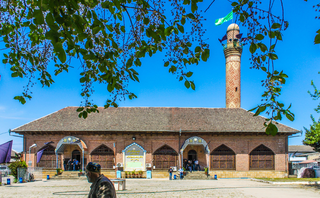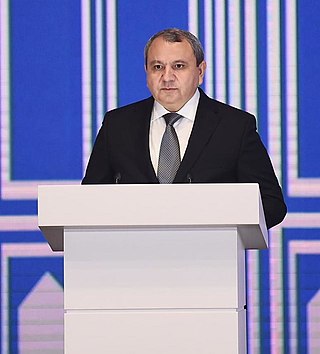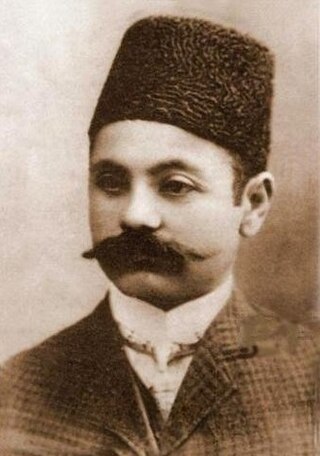
"Azərbaycan marşı" is the national anthem of Azerbaijan. The music was composed by Uzeyir Hajibeyov, and the lyrics were written by poet Ahmad Javad or cultural figure and politician Jamo bey Hajinski. The government officially adopted the anthem in 1920, with the passage of the decree, "On the State Hymn of the Republic of Azerbaijan". In 1992, after the fall of the Soviet Union, Azerbaijan's government officially restored "Azərbaycan Marşı" as the national anthem.
Çələbilər the ruins of a village located 17 km west of the city of Jabrayil, within the Dagh Tumas administrative-territorial unit, Jabrayil district, Azerbaijan.

Sheikh Ibrahim mosque (Azerbaijani: Şeyx İbrahim məscidi is a historical mosque of the XV century. It is a part of Old City and located on A.Zeynalli street, in the city of Baku, in Azerbaijan.

Abdulhamid Bey Sharif Bey oglu Gaytabashi was the last Chief of General Staff of Azerbaijani Armed Forces of Azerbaijan Democratic Republic before its occupation by the Red Army in April 1920.

Shaki Khan's Mosque, previously First Khan Mosque is an 18th-century Azerbaijani mosque located in the city of Shaki.

The Haji Bani Mosque is one of the mosques of Azerbaijan, was built in the sixteenth century. It is located in Old City, Baku.

Aydin Balamirza oghlu Mammadov is an Azerbaijani historian, scientist-demographer, specialist on historical demography, Ph.D. in history, and associate professor of the department of "source study, historiography and methods" of Baku State University. He is one of the 100 Notable alumni of Baku State University.

The Imam Hussein Mosque or Ashumov Mosque is a historical and architectural monument dating back to the 19th century. It is located in the city of Baku, Azerbaijan.

The Boyuk Bazar Mosque is a mosque in the city of Lankaran, Azerbaijan. The mosque was built in 1864 in the Boyuk Bazar neighborhood.

The Kichik Bazar Mosque is a mosque and historical architectural monument located in the center of the Lankaran district of Azerbaijan. The mosque was built in 1904.

Elchin Safarali oglu Babayev is an Azerbaijani scientist, Doctor of Philosophy in physical and mathematical Sciences, associate professor. Rector of Baku State University

Javad bey Mammad agha oghlu Shikhlinski was an officer of the Tsarist army, a major general of the Azerbaijan Republic Army, and the commander of the Ardabil garrison in the Qajar army.
Tofig Mammadali Aghababayev is an Azerbaijani painter, People's Artist of Azerbaijan (2007).

Orujov Oruj Ali oglu was a press official, publisher, and publicist.

Nizamaddin Mosque is a 14th-century mosque located in the Amirjan settlement of Baku, Azerbaijan.
Kochakhmedli Mosque is an architectural monument located in the village of Qoçəhmədli in Azerbaijan's Fuzuli district.
Chalabilar Mosque is a local significant historical and architectural monument dating back to the 17th century, located in the village of Çələbilər in Jabrayil district.

Sheikh Muhammad Mosque is a historical mosque and architectural monument dating from the 16th century. It is located in the "Basqal" State Historical-Cultural Reserve in Azerbaijan.

Hil mosque is a mosque located in the village of Hil in the Qusar district of Azerbaijan.
Yagub Mikayil oghlu Mahmudov Azerbaijani historian, Doctor of historical sciences, professor, a full member of ANAS, honored scientist of Azerbaijan and Dagestan, Laureate of State Prize of the Republic of Azerbaijan, Head of the Department of Ancient and Middle Ages History of Baku State University
















